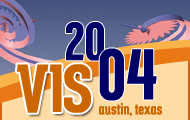 |
| VIS SESSIONS | ||||
| |
Capstone Speaker Friday, October
15
Pat Hanrahan (Stanford University)
"Self Illustrating Phenomena" Abstract
A self-illustrating phenomenon is an image which exposes the
science behind it. (I first saw this term in
H. Robin's book, "The Scientific Image"). Some famous examples
are pictures of iron filings aligned along magnetic lines of force,
sand particles collecting at the stationary points of the standing waves
of a violin,
stress in a mechanical part revealed through birefringence, and
particle tracks in a bubble chamber. Such images brilliantly combine
experimental design, analysis, and visualization.
Quoting J. Tukey, "the general purposes of
conducting experiments and analyzing data match, point by
point." I will argue in this talk that computer
tools for visual analysis should normally be conceived of as
aids in constructing computational visual experiments; and that
the resulting visualizations be
consciously designed to help validate or invalidate the hypothesis
being tested by the experiment.
Bio Pat Hanrahan is the CANON USA Professor of Computer Science and Electrical Engineering at Stanford University where he teaches computer graphics. His current research involves visualization, image synthesis, and graphics systems and architectures. Before joining Stanford he was a faculty member at Princeton. He has also worked at Pixar where he developed developed volume rendering software and was the chief architect of the RenderMan™ Interface - a protocol that allows modeling programs to describe scenes to high quality rendering programs. Previous to Pixar he directed the 3D computer graphics group in the Computer Graphics Laboratory at New York Institute of Technology. Professor Hanrahan has received three university teaching awards, two Academy Awards for Science and Technology, the Spirit of America Creativity Award, the SIGGRAPH Computer Graphics Achievement Award, and the SIGGRAPH Stephen A. Coons Award. He was recently elected to the National Academy of Engineering. |
|||